Exploring the Application of the FOX Model to Foster Pro-Environmental Behaviours in Smart Environments †
Abstract
1. Introduction
1.1. Applied Research Methods
2. Background
2.1. Theoretical Frameworks of Sustainable Behaviour Change
2.2. Existing User Models and Characterisations in the Context of Pro-Environmentalism
2.3. Other Approaches to Sustainable Behaviour
2.4. Insights Extracted from the Literature Analysis
3. The Proposed FOX Model
3.1. Mapping the Dimensions: The Meta-Model
3.2. Stages of Change
3.3. Personality
3.4. Attitudes
3.5. Behavioural Control
3.6. Subjective Norm
3.7. Values
3.8. Beliefs
4. Exploring Potential Applications of FOX
4.1. Procedure
4.2. Results and Insights
4.2.1. Interviewee 1: Male, Post-Doctoral Researcher in Health-Related Artificial Intelligence Applications
4.2.2. Interviewee 2: Female, Pre-Doctoral Researcher in the Field of ICT in Education
4.2.3. Interviewee 3: Male, Post-Graduate Student in Computer Science and Research Assistant in an H2020 Project Related to Energy Efficiency
4.2.4. Interviewee 4: Male, Researcher in the Field of Energy Efficiency
4.2.5. Interviewee 5: Male, Researcher in the Field of the Internet of Things and Human-Computer Interaction
4.2.6. Interviewee 6: Male, Researcher in the Field of Artificial Intelligence Applied to Natural Language Processing and Activity Recognition
4.2.7. Interviewee 7: Female, Researcher and Software Developer in Energy Efficiency-Related Research Projects
4.2.8. Interviewee 8: Male, Researcher in the Field of Next-Generation Internet
4.3. Conclusions and Insights for the Potential Future Performance of the Fox Model
5. Applying the FOX Model
5.1. Developing User Profiles: Jon, Lily, and Sua
5.1.1. Jon
5.1.2. Lily
5.1.3. Sua
5.2. Understanding Actors in Their Context
5.2.1. Jon and His Workplace
5.2.2. Lily at Her Home
5.2.3. Sua and Her Family
5.3. Conclusions and Insights
6. Discussion
7. Conclusions
Author Contributions
Funding
Acknowledgments
Conflicts of Interest
References
- Sánchez-Corcuera, R.; Nuñez-Marcos, A.; Sesma-Solance, J.; Bilbao-Jayo, A.; Mulero, R.; Zulaika, U.; Azkune, G.; Almeida, A. Smart cities survey: Technologies, application domains and challenges for the cities of the future. Int. J. Distrib. Sens. Netw. 2019, 15, 1550147719853984. [Google Scholar] [CrossRef]
- Irizar-Arrieta, A.; Retegi, A.; Casado-Mansilla, D.; Laschke, M.; López-de Ipiña, D. FOX: A flexible and heterogeneus mixed user model to address sustainable behaviour in smart wnvironments. In Proceedings of the Multidisciplinary Digital Publishing Institute Proceedings, Toledo, Spain, 2–4 December 2019; Volume 31, p. 82. [Google Scholar]
- Mankoff, J.C.; Blevis, E.; Borning, A.; Borning, A.; Friedman, B.; Fussell, S.R.; Hasbrouck, J.; Woodruff, A.; Sengers, P. Environmental sustainability and interaction. In Proceedings of the ACM CHI’07 Extended Abstracts on Human Factors in Computing Systems, San Jose, CA, USA, 28 April–3 May 2007; pp. 2121–2124. [Google Scholar]
- DiSalvo, C.; Sengers, P.; Brynjarsdóttir, H. Mapping the landscape of sustainable HCI. In Proceedings of the ACM SIGCHI Conference on Human Factors in Computing Systems, Atlanta, GA, USA, 10–15 April 2010; pp. 1975–1984. [Google Scholar]
- Bravo, J.; Fuentes, L.; de Ipina, D.L. Theme Issue: “Ubiquitous Computing and Ambient Intelligence”; Springer: Berlin/Heidelberg, Germany, 2011. [Google Scholar]
- Coskun, A.; Erbug, C. User diversity in design for behavior change. In Proceedings of the DRS, Umea, Sweden, 16–19 June 2014; pp. 546–559. [Google Scholar]
- Hekler, E.B.; Klasnja, P.; Froehlich, J.E.; Buman, M.P. Mind the theoretical gap: Interpreting, using, and developing behavioral theory in HCI research. In Proceedings of the ACM SIGCHI Conference on Human Factors in Computing Systems, Paris, France, 27 April–2 May 2013; pp. 3307–3316. [Google Scholar]
- Irizar-Arrieta, A.; Casado-Mansilla, D. Coping with user diversity: UX informs the design of a digital interface that encourages sustainable behaviour. In Proceedings of the 11th Multi Conference on Computer Science and Information Systems, Lisbon, Portugal, 20–23 July 2017. [Google Scholar]
- Irizar-Arrieta, A.; Casado-Mansilla, D.; Retegi, A. Accounting for user diversity in the design for sustainable behaviour in smart offices. In Proceedings of the IEEE 2018 3rd International Conference on Smart and Sustainable Technologies (SpliTech), Split, Croatia, 26–29 June 2018; pp. 1–6. [Google Scholar]
- Buchanan, E.A.; Hvizdak, E.E. Online survey tools: Ethical and methodological concerns of human research ethics committees. J. Empir. Res. Hum. Res. Ethics 2009, 4, 37–48. [Google Scholar] [CrossRef] [PubMed]
- Evans, J.R.; Mathur, A. The value of online surveys. Internet Res. 2005, 15, 195–219. [Google Scholar] [CrossRef]
- Schwandt, T.A.; Gates, E.F. Case study methodology. Sage Handb. Qual. Res. 2018, 5, 341–358. [Google Scholar]
- Hosono, S.; Hasegawa, M.; Hara, T.; Shimomura, Y.; Arai, T. A methodology of persona-centric service design. In Proceedings of the 19th CIRP Design Conference–Competitive Design, Cranfield, UK, 30–31 March 2019; Cranfield University Press: Cranfield, UK, 2009. [Google Scholar]
- Blomkvist, S. Persona—An overview. Retrieved Novemb. 2002, 22, 2004. [Google Scholar]
- Pruitt, J.; Grudin, J. Personas: Practice and theory. In Proceedings of the 2003 Conference on Designing for User Experiences, San Francisco, CA, USA, 6–7 June 2003; pp. 1–15. [Google Scholar]
- So, C.; Joo, J. Does a persona improve creativity? Des. J. 2017, 20, 459–475. [Google Scholar] [CrossRef]
- He, H.A.; Greenberg, S.; Huang, E.M. One size does not fit all: Applying the transtheoretical model to energy feedback technology design. In Proceedings of the ACM SIGCHI Conference on Human Factors in Computing Systems, Atlanta, GA, USA, 10–15 April 2010; pp. 927–936. [Google Scholar]
- Prochaska, J.O.; Redding, C.A.; Evers, K.E. The transtheoretical model and stages of change. Health Behav. Theory Res. Pract. 2015, 97, 125–148. [Google Scholar]
- Coskun, A.; Erbug, C. Exploring and communicating user diversity for behavioural change. In Proceedings of the 2016 Design Research Society 50th Anniversary Conference, Brighton, UK, 27–30 June 2016; Volume 4, pp. 1357–1374. [Google Scholar] [CrossRef]
- Madsen, S.; Nielsen, L. Exploring persona-scenarios-using storytelling to create design ideas. In Proceedings of the IFIP Working Conference on Human Work Interaction Design, Pune, India, 7–8 October 2009; Springer: Berlin/Heidelberg, Germany, 2009; pp. 57–66. [Google Scholar]
- Madsen, S.; Nielsen, L. Using storytelling to improve scenarios. In Proceedings of the IADIS International Conference Information Systems, Barcelona, Spain, 25–27 February 2009. [Google Scholar]
- Coskun, A.; Zimmerman, J.; Erbug, C. Promoting sustainability through behavior change: A review. Des. Stud. 2015, 41, 183–204. [Google Scholar] [CrossRef]
- Irizar-Arrieta, A.; Gómez-Carmona, O.; Bilbao-Jayo, A.; Casado-Mansilla, D.; Lopez-De-Ipina, D.; Almeida, A. Addressing behavioural technologies through the human factor: A review. IEEE Access 2020, 8, 52306–52322. [Google Scholar] [CrossRef]
- Wising, U.; Chirez, S.; Adams, B. Improving industrial energy efficiency by changing the energy culture. In Proceedings of the ECEEE Industrial Summer Study Proceedings, Arnhem, The Netherlands, 2–5 June 2014. [Google Scholar]
- Xiao, J.J. Developing action-taking programs in sustainable consumption education: Applying the transtheoretical model of behavior change (TTM). SSRN 2019. [Google Scholar] [CrossRef]
- Stern, P.C.; Dietz, T.; Abel, T.; Guagnano, G.A.; Kalof, L. A value-belief-norm theory of support for social movements: The case of environmentalism. Hum. Ecol. Rev. 1999, 6, 81–97. [Google Scholar]
- Stern, P.C. New environmental theories: Toward a coherent theory of environmentally significant behavior. J. Soc. Issues 2000, 56, 407–424. [Google Scholar] [CrossRef]
- Petkov, P.; Goswami, S.; Köbler, F.; Krcmar, H. Personalised eco-feedback as a design technique for motivating energy saving behaviour at home. In Proceedings of the ACM 7th Nordic Conference on Human-Computer Interaction: Making Sense Through Design, Copenhagen, Denmark, 14–17 October 2012; pp. 587–596. [Google Scholar]
- Ajzen, I. The theory of planned behavior. Organ. Behav. Hum. Decis. Process. 1991, 50, 179–211. [Google Scholar] [CrossRef]
- Greaves, M.; Zibarras, L.D.; Stride, C. Using the theory of planned behavior to explore environmental behavioral intentions in the workplace. J. Environ. Psychol. 2013, 34, 109–120. [Google Scholar] [CrossRef]
- Lockton, D.; Harrison, D.; Stanton, N.A. Models of the user: Designers’ perspectives on influencing sustainable behaviour. J. Des. Res. 2012, 10, 7–27. [Google Scholar] [CrossRef]
- Cor, E.; Zwolinski, P. A procedure to define the best design intervention strategy on a product for a sustainable behavior of the user. Procedia CIRP 2014, 15, 425–430. [Google Scholar] [CrossRef][Green Version]
- Lilley, D.; Bailey, V.; Charnley, F. Design for Sustainable Behaviour: A Quick Fix for Slower Consumption? Loughborough University: Loughborough, UK, 2013. [Google Scholar]
- Halko, S.; Kientz, J.A. Personality and persuasive technology: An exploratory study on health-promoting mobile applications. In Proceedings of the International Conference on Persuasive Technology, Copenhagen, Denmark, 7–10 June 2010; Springer: Berlin/Heidelberg, Germany, 2010; pp. 150–161. [Google Scholar]
- Kaptein, M.; Lacroix, J.; Saini, P. Individual differences in persuadability in the health promotion domain. In Proceedings of the International Conference on Persuasive Technology, Copenhagen, Denmark, 7–10 June 2010; Springer: Berlin/Heidelberg, Germany, 2010; pp. 94–105. [Google Scholar]
- Kaptein, M.; Markopoulos, P.; De Ruyter, B.; Aarts, E. Personalizing persuasive technologies: Explicit and implicit personalization using persuasion profiles. Int. J. Hum. Comput. Stud. 2015, 77, 38–51. [Google Scholar] [CrossRef]
- Lilley, D. Design for sustainable behaviour: Strategies and perceptions. Des. Stud. 2009, 30, 704–720. [Google Scholar] [CrossRef]
- Michie, S.; Ashford, S.; Sniehotta, F.F.; Dombrowski, S.U.; Bishop, A.; French, D.P. A refined taxonomy of behaviour change techniques to help people change their physical activity and healthy eating behaviours: The CALO-RE taxonomy. Psychol. Health 2011, 26, 1479–1498. [Google Scholar] [CrossRef]
- Michie, S.; Johnston, M.; Francis, J.; Hardeman, W.; Eccles, M. From theory to intervention: Mapping theoretically derived behavioural determinants to behaviour change techniques. Appl. Psychol. 2008, 57, 660–680. [Google Scholar] [CrossRef]
- Michie, S.; Van Stralen, M.M.; West, R. The behaviour change wheel: A new method for characterising and designing behaviour change interventions. Implement. Sci. 2011, 6, 42. [Google Scholar] [CrossRef] [PubMed]
- Atkins, L.; Francis, J.; Islam, R.; O’Connor, D.; Patey, A.; Ivers, N.; Foy, R.; Duncan, E.M.; Colquhoun, H.; Grimshaw, J.M.; et al. A guide to using the Theoretical Domains Framework of behaviour change to investigate implementation problems. Implement. Sci. 2017, 12, 77. [Google Scholar] [CrossRef]
- Gainforth, H.L.; Sheals, K.; Atkins, L.; Jackson, R.; Michie, S. Developing interventions to change recycling behaviors: A case study of applying behavioral science. Appl. Environ. Educ. Commun. 2016, 15, 325–339. [Google Scholar] [CrossRef]
- Morgan, E.; Webb, L.; Carter, K.; Goddard, N. Co-designing a device for behaviour-based energy reduction in a large organisation. Proc. ACM Hum. Comput. Interact. 2018, 2, 125. [Google Scholar] [CrossRef]
- Yun, R.; Aziz, A.; Lasternas, B.; Loftness, V.; Scupelli, P.; Zhang, C. The persistent effectiveness of online feedback and controls for sustainability in the workplace. Energy Effic. 2017. [Google Scholar] [CrossRef]
- Bao, Q.; Burnell, E.; Hughes, A.M.; Yang, M.C. Investigating user emotional responses to eco-feedback designs. J. Mech. Des. 2019, 141, 021103. [Google Scholar] [CrossRef]
- Bao, Q.; Shaukat, M.M.; Elantary, A.; Yang, M.C. Eco-feedback designs: A balance between the quantitative and the emotional. In Proceedings of the ASME 2016 International Design Engineering Technical Conferences and Computers and Information in Engineering Conference. American Society of Mechanical Engineers, Cleveland, OH, USA, 21–24 August 2016; p. V007T06A022. [Google Scholar]
- Lockton, D.; Harrison, D.; Stanton, N.A. Modelling the User: How Design for Sustainable Behaviour Can Reveal Different Stakeholder Perspectives on Human Nature; University of Southampton: Southampton, UK, 2010. [Google Scholar]
- Ajzen, I. Perceived behavioral control, self-efficacy, locus of control, and the theory of planned behavior. J. Appl. Soc. Psychol. 2002, 32, 665–683. [Google Scholar] [CrossRef]

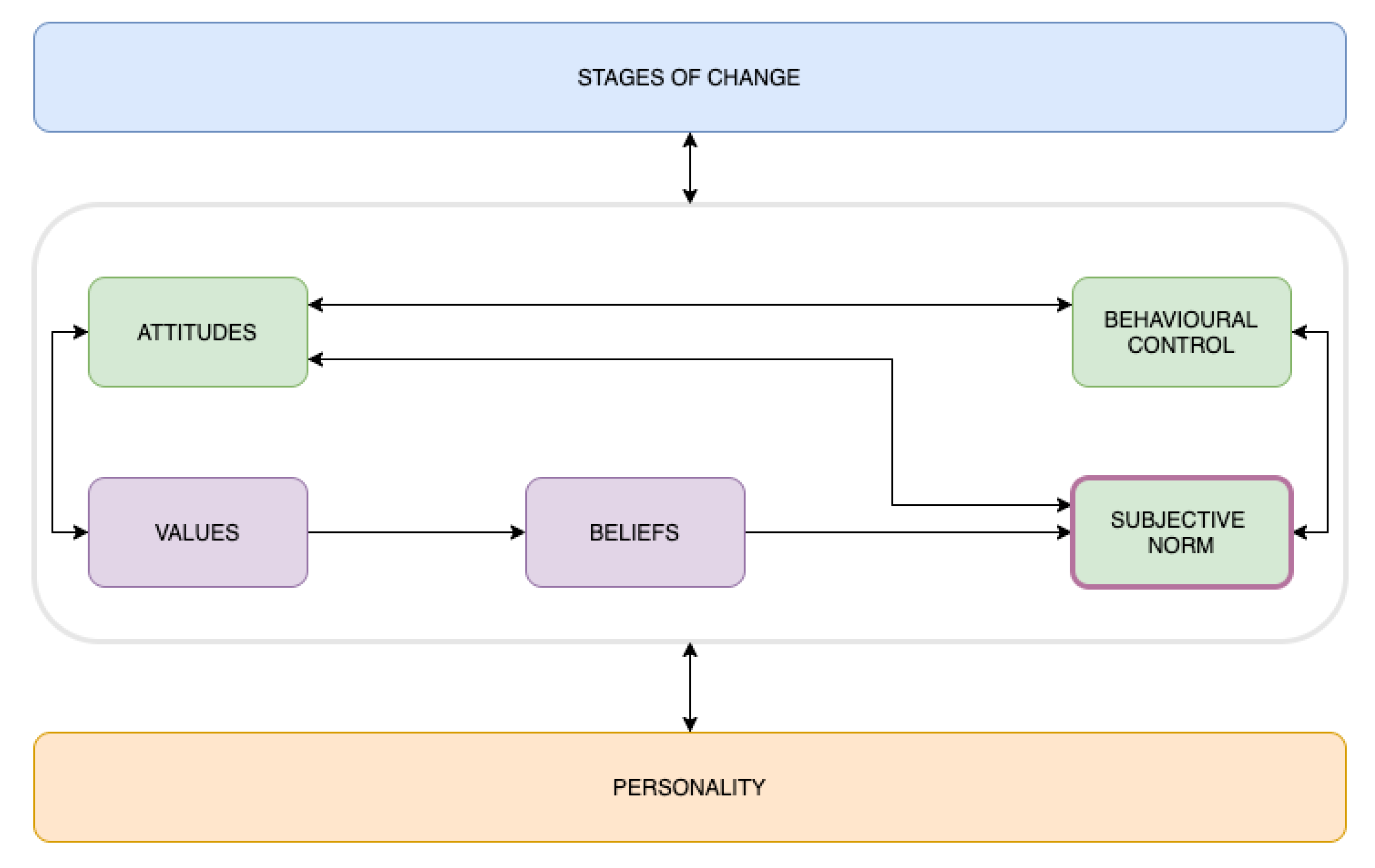
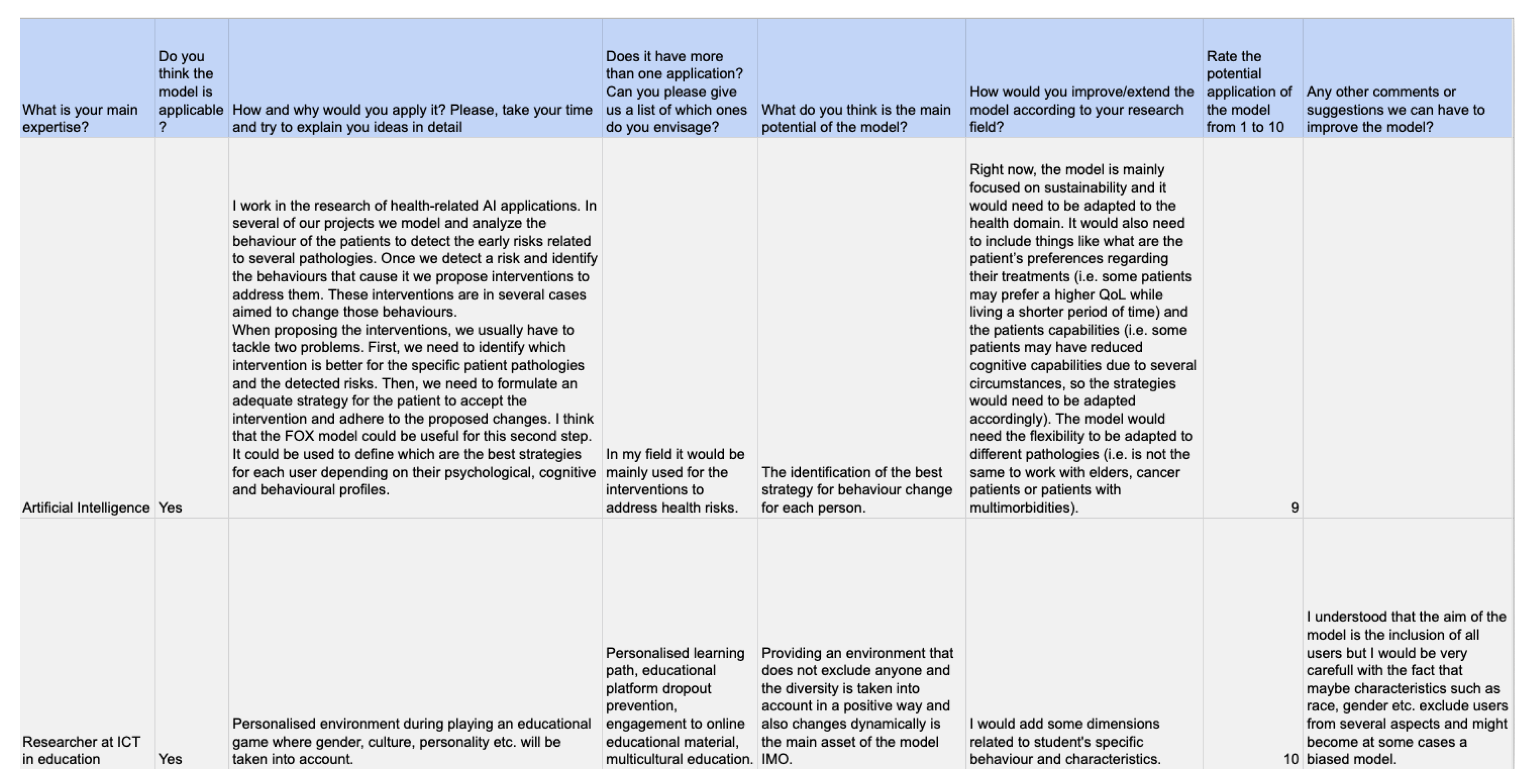
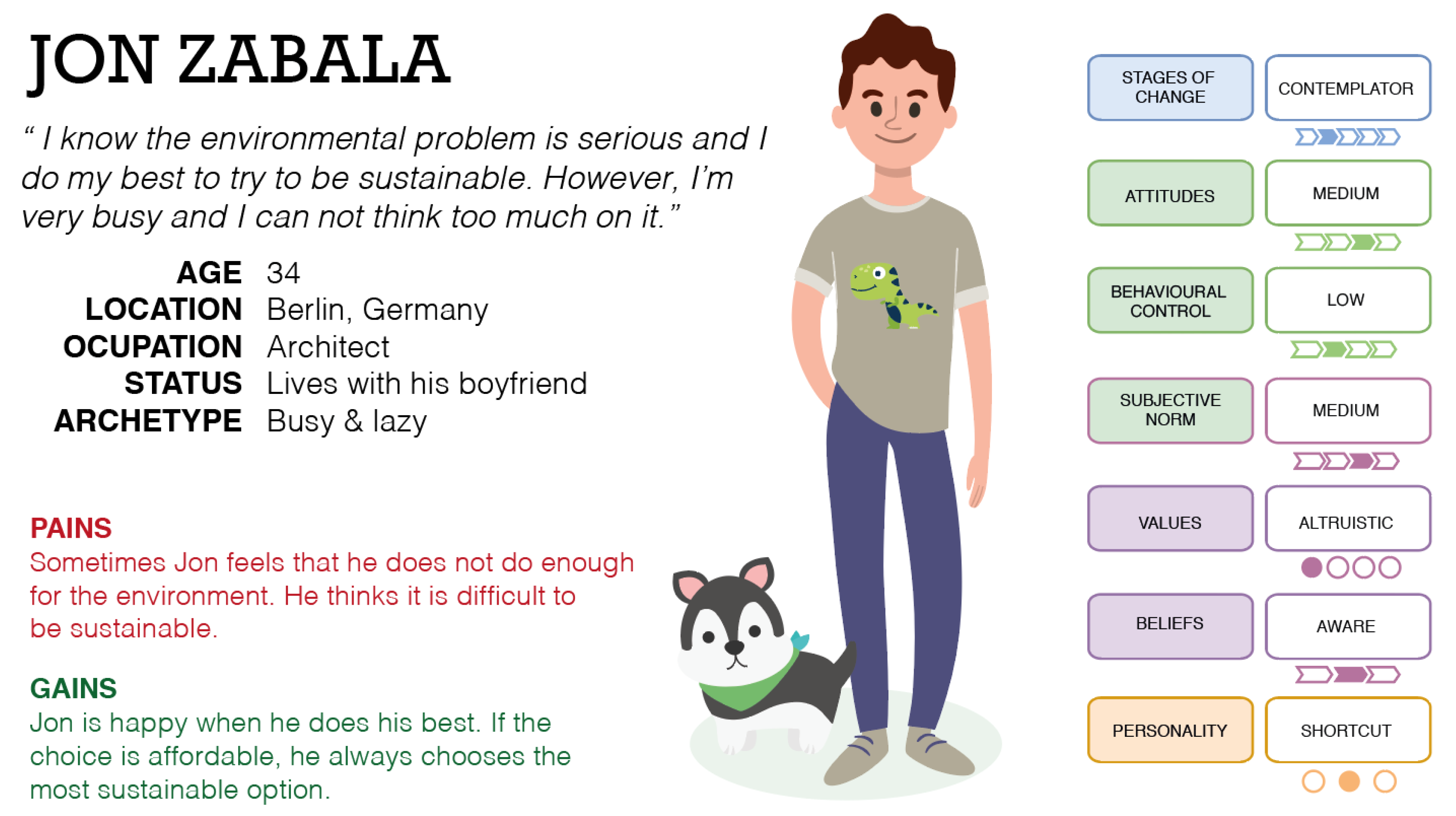
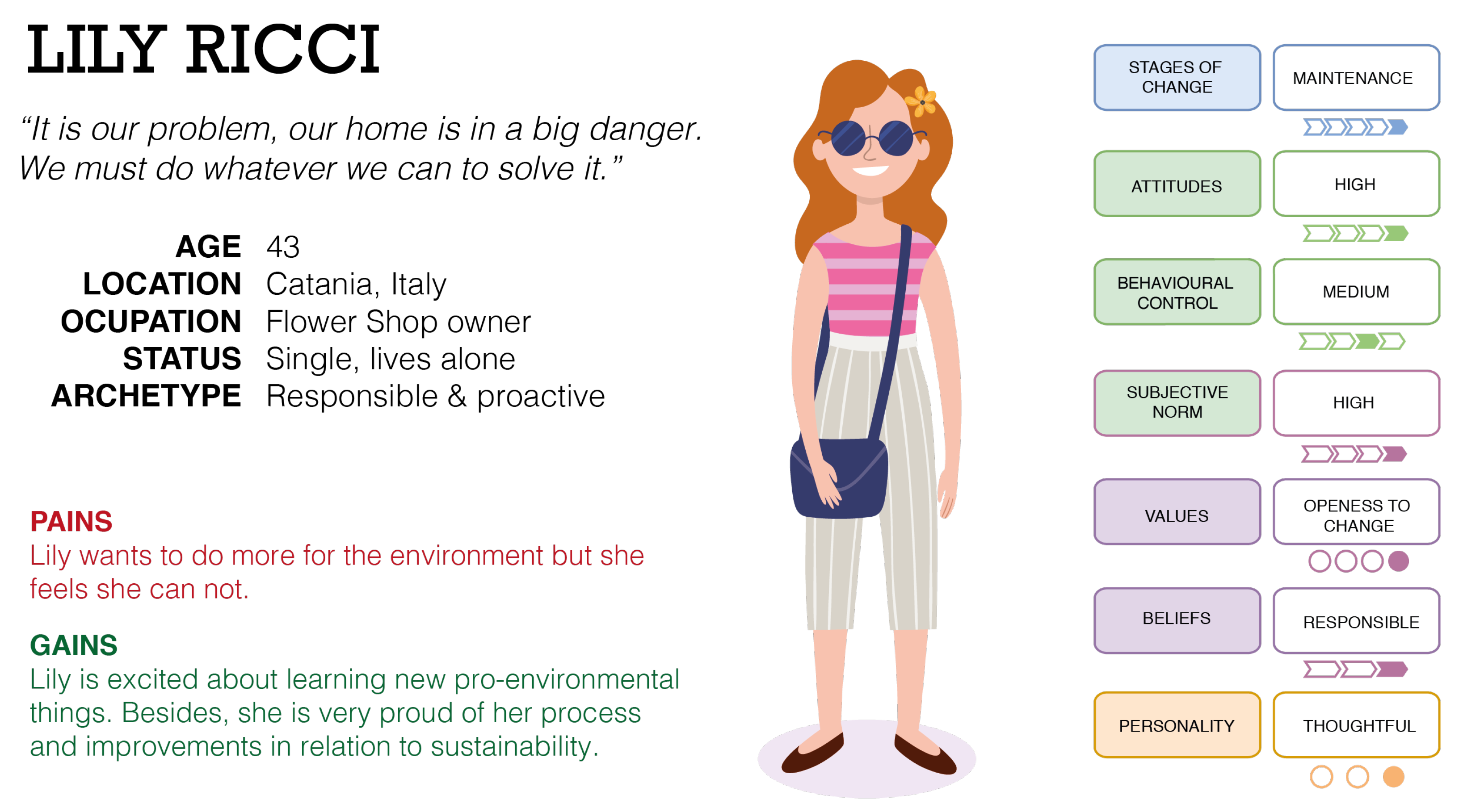

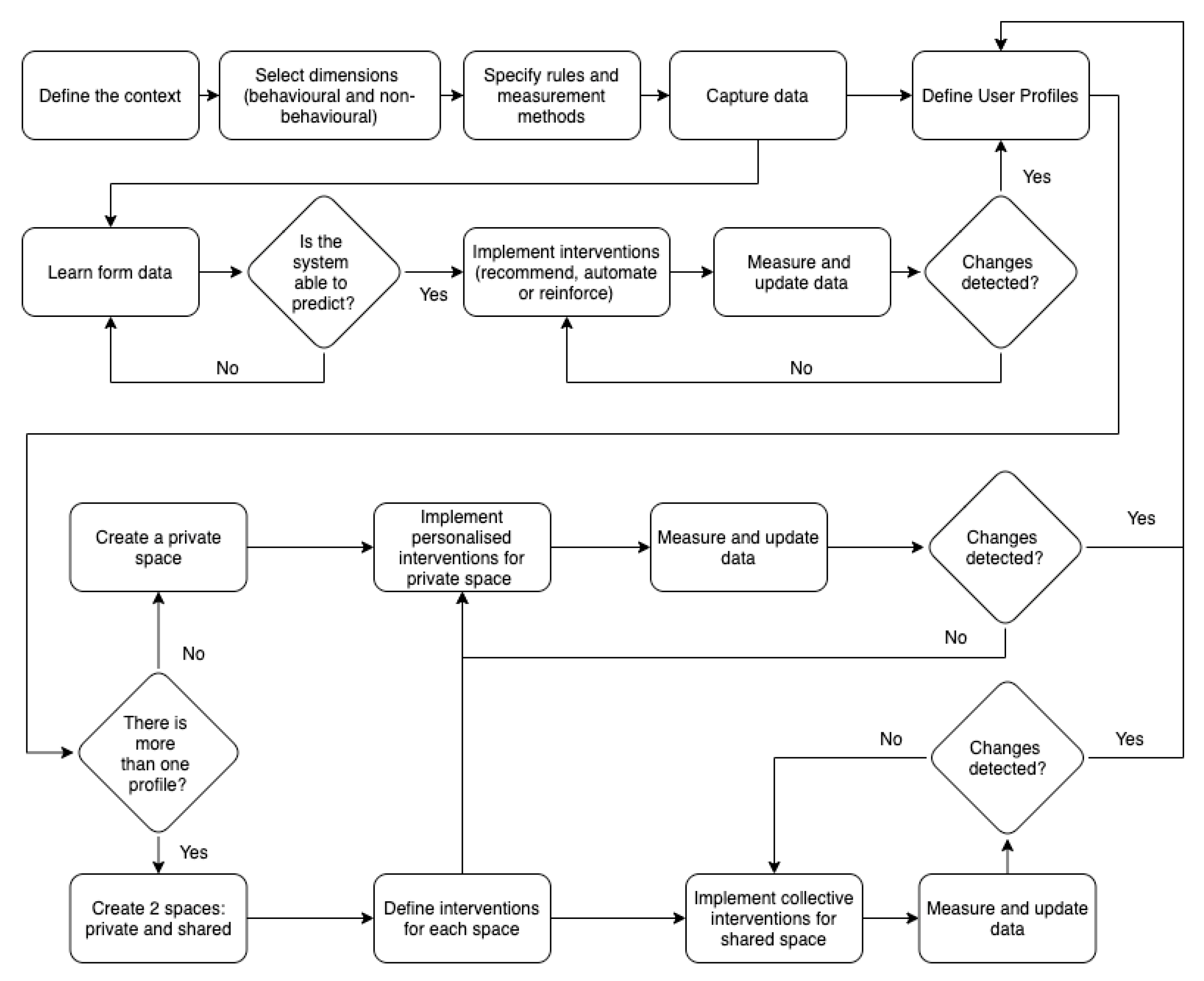



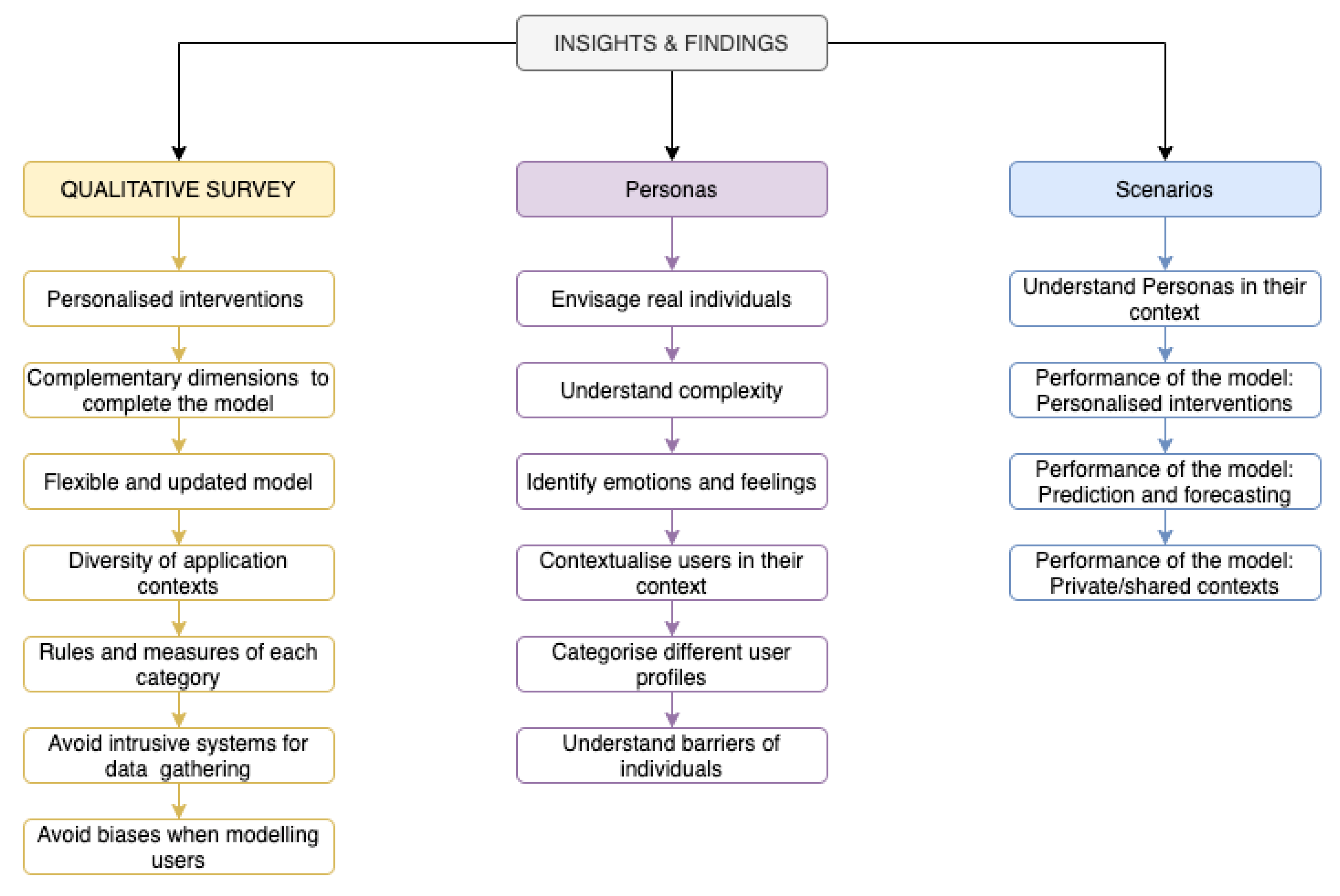
| Authors | Description and Key Points |
|---|---|
| He et al., 2010 [17] | Application of TTM to define interventions for one specific Persona. |
| Halko and Kientz, 2010 [34] | Understanding differences in personality, in relation to behavioural techniques. |
| Kaptein, Lacroix, and Saini, 2010 [35] | User profiles linked with the persuasive level and personalised inputs. |
| Lockton et al., 2012 [31] | Definition of three user profiles in relation to behavioural traits. |
| Petkov et al., 2012 [28] | Application of VBN, identifying profiles to address personalisation. |
| Lilley, Bailey, and Charnley, 2013 [33] | Development of three Personas and specific strategies for them. |
| Cor and Zwolinksi, 2014 [32] | Identification of two types of individuals to set design interventions. |
| Coskun and Erburg, 2016 [19] | Identification of four personas based on the TPB. |
| Authors | Description and Key Points |
|---|---|
| Michie, 2008 [39] | Exploration of behaviour change techniques with behaviour determinants. |
| Lilley, 2009 [37] | Definition of DfSB, a framework to address behavioural interventions. |
| Michie, 2011 [38], | Definition of a taxonomy of behaviour change techniques. |
| Michie, 2011 [40] | Development of BCW, a tool to select the best behavioural strategy. |
| Gainforth, 2016 [42] | Application of TDF to foster recycling behaviours. |
| Bao et al., 2016 [46] | Analysis of quantitative and emotional eco-feedback. |
| Atkins, 2017 [41] | Definition of TDF, a framework addressing behaviours of individuals. |
| Yun, Aziz, and Lasternas, 2017 [44] | Analysis of online feedback and control strategies in the workplace context. |
| Morgan et al., 2018 [43] | Research work about co-design in a large organisation to boost sustainability. |
| Bao et al., 2019 [45] | Analysis of emotional eco-feedback. |
© 2020 by the authors. Licensee MDPI, Basel, Switzerland. This article is an open access article distributed under the terms and conditions of the Creative Commons Attribution (CC BY) license (http://creativecommons.org/licenses/by/4.0/).
Share and Cite
Irizar-Arrieta, A.; Casado-Mansilla, D.; Retegi, A.; Laschke, M.; López-de-Ipiña, D. Exploring the Application of the FOX Model to Foster Pro-Environmental Behaviours in Smart Environments. Sensors 2020, 20, 4576. https://doi.org/10.3390/s20164576
Irizar-Arrieta A, Casado-Mansilla D, Retegi A, Laschke M, López-de-Ipiña D. Exploring the Application of the FOX Model to Foster Pro-Environmental Behaviours in Smart Environments. Sensors. 2020; 20(16):4576. https://doi.org/10.3390/s20164576
Chicago/Turabian StyleIrizar-Arrieta, Ane, Diego Casado-Mansilla, Aiur Retegi, Matthias Laschke, and Diego López-de-Ipiña. 2020. "Exploring the Application of the FOX Model to Foster Pro-Environmental Behaviours in Smart Environments" Sensors 20, no. 16: 4576. https://doi.org/10.3390/s20164576
APA StyleIrizar-Arrieta, A., Casado-Mansilla, D., Retegi, A., Laschke, M., & López-de-Ipiña, D. (2020). Exploring the Application of the FOX Model to Foster Pro-Environmental Behaviours in Smart Environments. Sensors, 20(16), 4576. https://doi.org/10.3390/s20164576








